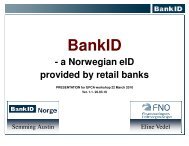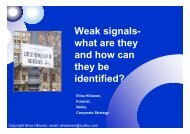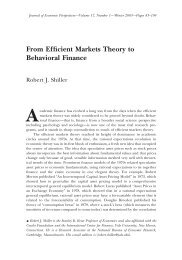A Network Approach to E-identification
A Network Approach to E-identification
A Network Approach to E-identification
- No tags were found...
Create successful ePaper yourself
Turn your PDF publications into a flip-book with our unique Google optimized e-Paper software.
4<br />
A <strong>Network</strong> <strong>Approach</strong>: ‘E-ID as a Scheme’<br />
The network approach we present in this document is not a new approach, but an existing<br />
solution applied <strong>to</strong> e-ID. It is based on the ‘scheme’ approach used in the past <strong>to</strong><br />
solve network and scale problems that arose with global payment networks. Currently<br />
this network approach is being developed in the Netherlands. To explain how this<br />
network approach can help <strong>to</strong> develop secure e-<strong>identification</strong>, we will start <strong>to</strong> explain<br />
the concept of the two-sided network and the basic elements of a scheme. Then we<br />
show how the concept of a scheme can be applied <strong>to</strong> create an e-ID scheme. In the last<br />
section we show what value added services the scheme concept can bring, in order <strong>to</strong><br />
meet existing needs and stimulate further innovation.<br />
4.1 Two-sided networks<br />
A two-sided network distinguishes two types of users that interact with each other, using<br />
a common infrastructure. Examples of two-sided networks can be found in the area of<br />
electronic payments, as for instance credit card networks. With credit card payments,<br />
consumers (cardholders) and merchants (acceptants) both use a common infrastructure<br />
that facilitates the transaction, while the two types of users have distinct requirements<br />
regarding the services that are offered <strong>to</strong> them. What they have in common is that they<br />
both benefit from the size of the other side of the network. In other words: cardholders<br />
benefit from the number of merchants that accept their card, and merchants benefit<br />
if many consumers hold the credit card that they accept. This is what is called a crosssided<br />
network effect 5 . In a network paradigm, electronic <strong>identification</strong> can be considered<br />
as a two-sided network with cross-sided network effects 6 .<br />
The evolution of global payment systems in the 1970’s was supported by the implementation<br />
of 4-party model schemes. The 4-party model implies that the two sides of the<br />
market, the consumer side and the merchant side, obtain their required services from<br />
different parties. These parties offer their services in competition with each other while<br />
giving the users access <strong>to</strong> the same network. This provides scalability, a competitive<br />
market and network effects. This is opposed <strong>to</strong> a 3-party model, where there is a single<br />
central party <strong>to</strong> which both consumers and merchants have <strong>to</strong> connect.<br />
5 Opposed <strong>to</strong> the cross-sided network effect is the same-sided network effect. This refers <strong>to</strong> the benefits<br />
gained from the growth of the same side of the network.<br />
6 Examples of international credit card schemes include Visa and MasterCard.<br />
17
















